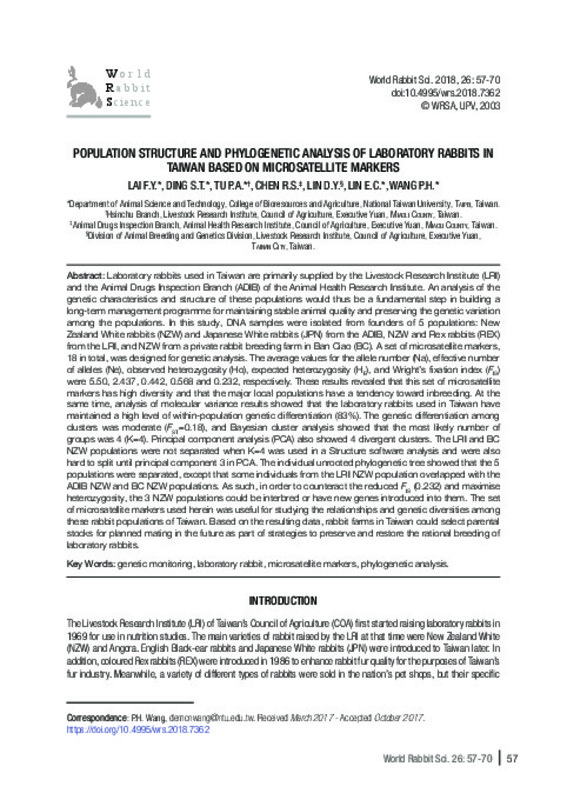JavaScript is disabled for your browser. Some features of this site may not work without it.
Buscar en RiuNet
Listar
Mi cuenta
Estadísticas
Ayuda RiuNet
Admin. UPV
Population structure and phylogenetic analysis of laboratory rabbits in Taiwan based on microsatellite markers
Mostrar el registro sencillo del ítem
Ficheros en el ítem
| dc.contributor.author | Lai, Fang-Yu
|
es_ES |
| dc.contributor.author | Ding, Shih-Torng
|
es_ES |
| dc.contributor.author | Tu, Po-An
|
es_ES |
| dc.contributor.author | Chen, R.S.
|
es_ES |
| dc.contributor.author | Lin, Der-Yuh
|
es_ES |
| dc.contributor.author | Lin, En-Cheng
|
es_ES |
| dc.contributor.author | Wang, Pei-Hwa
|
es_ES |
| dc.date.accessioned | 2018-04-10T08:33:07Z | |
| dc.date.available | 2018-04-10T08:33:07Z | |
| dc.date.issued | 2018-03-28 | |
| dc.identifier.issn | 1257-5011 | |
| dc.identifier.uri | http://hdl.handle.net/10251/100100 | |
| dc.description.abstract | [EN] Laboratory rabbits used in Taiwan are primarily supplied by the Livestock Research Institute (LRI) and the Animal Drugs Inspection Branch (ADIB) of the Animal Health Research Institute. An analysis of the genetic characteristics and structure of these populations would thus be a fundamental step in building a long-term management programme for maintaining stable animal quality and preserving the genetic variation among the populations. In this study, DNA samples were isolated from founders of 5 populations: New Zealand White rabbits (NZW) and Japanese White rabbits (JPN) from the ADIB, NZW and Rex rabbits (REX) from the LRI, and NZW from a private rabbit breeding farm in Ban Ciao (BC). A set of microsatellite markers, 18 in total, was designed for genetic analysis. The average values for the allele number (Na), effective number of alleles (Ne), observed heterozygosity (Ho), expected heterozygosity (HE), and Wright’s fixation index (FIS) were 5.50, 2.437, 0.442, 0.568 and 0.232, respectively. These results revealed that this set of microsatellite markers has high diversity and that the major local populations have a tendency toward inbreeding. At the same time, analysis of molecular variance results showed that the laboratory rabbits used in Taiwan have maintained a high level of within-population genetic differentiation (83%). The genetic differentiation among clusters was moderate (FST=0.18), and Bayesian cluster analysis showed that the most likely number of groups was 4 (K=4). Principal component analysis (PCA) also showed 4 divergent clusters. The LRI and BC NZW populations were not separated when K=4 was used in a Structure software analysis and were also hard to split until principal component 3 in PCA. The individual unrooted phylogenetic tree showed that the 5 populations were separated, except that some individuals from the LRI NZW population overlapped with the ADIB NZW and BC NZW populations. As such, in order to counteract the reduced FIS (0.232) and maximise heterozygosity, the 3 NZW populations could be interbred or have new genes introduced into them. The set of microsatellite markers used herein was useful for studying the relationships and genetic diversities among these rabbit populations of Taiwan. Based on the resulting data, rabbit farms in Taiwan could select parental stocks for planned mating in the future as part of strategies to preserve and restore the rational breeding of laboratory rabbits. | es_ES |
| dc.description.sponsorship | This work was financially supported in part by the Council of Agriculture, Executive Yuan, Taiwan (Grant No.: 100 AS-5.3.1-ST-aD and 101AS-6.1.1-ST-aC). We would also like to acknowledge the National Center for Genome Medicine, National Science Council, Taiwan, for their technical support. | es_ES |
| dc.language | Inglés | es_ES |
| dc.publisher | Universitat Politècnica de València | |
| dc.relation.ispartof | World Rabbit Science | |
| dc.rights | Reserva de todos los derechos | es_ES |
| dc.subject | Genetic monitoring | es_ES |
| dc.subject | Laboratory rabbit | es_ES |
| dc.subject | Microsatellite markers | es_ES |
| dc.subject | Phylogenetic analysis | es_ES |
| dc.title | Population structure and phylogenetic analysis of laboratory rabbits in Taiwan based on microsatellite markers | es_ES |
| dc.type | Artículo | es_ES |
| dc.date.updated | 2018-04-10T07:02:31Z | |
| dc.identifier.doi | 10.4995/wrs.2018.7362 | |
| dc.relation.projectID | info:eu-repo/grantAgreement/COA//100 AS-5.3.1-ST-aD/ | |
| dc.relation.projectID | info:eu-repo/grantAgreement/COA//101AS-6.1.1-ST-aC/ | |
| dc.rights.accessRights | Abierto | es_ES |
| dc.description.bibliographicCitation | Lai, F.; Ding, S.; Tu, P.; Chen, R.; Lin, D.; Lin, E.; Wang, P. (2018). Population structure and phylogenetic analysis of laboratory rabbits in Taiwan based on microsatellite markers. World Rabbit Science. 26(1):57-70. https://doi.org/10.4995/wrs.2018.7362 | es_ES |
| dc.description.accrualMethod | SWORD | es_ES |
| dc.relation.publisherversion | https://doi.org/10.4995/wrs.2018.7362 | es_ES |
| dc.description.upvformatpinicio | 57 | es_ES |
| dc.description.upvformatpfin | 70 | es_ES |
| dc.type.version | info:eu-repo/semantics/publishedVersion | es_ES |
| dc.description.volume | 26 | |
| dc.description.issue | 1 | |
| dc.identifier.eissn | 1989-8886 | |
| dc.contributor.funder | Council of Agriculture, Taiwan |








